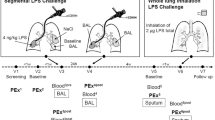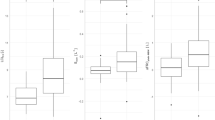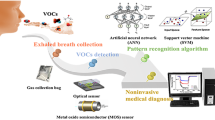Abstract
The assessment of airway inflammation by non-invasive methods could provide a signal to start anti-inflammatory treatment before the onset of symptoms and the impairment of lung function. It could also be useful in the follow-up of patients with lung disease, and for guiding drug treatment. Measuring inflammatory markers in exhaled breath condensate is potentially the easiest way to quantify lung inflammation. The clinical applicability of this method could facilitate the practice of respiratory medicine.
This is a preview of subscription content, access via your institution
Access options
Subscribe to this journal
Receive 12 print issues and online access
$209.00 per year
only $17.42 per issue
Buy this article
- Purchase on Springer Link
- Instant access to full article PDF
Prices may be subject to local taxes which are calculated during checkout


Similar content being viewed by others
References
Wielders, P. L. M. L. & Dekhuijzen, P. N. R. Disease monitoring in chronic obstructive pulmonary disease: is there a role for biomarkers? Eur. Respir. J. 10, 2443–2445 (1997).
Barnes, P. J., Chung, K. F. & Page, C. P. Inflammatory mediators of asthma: an update. Pharmacol. Rev. 50, 515–596 (1998).
Rutgers, S. R., Timens, W., Kauffman, H. F. & Postma, D. S. Markers of active airway inflammation and remodelling in chronic obstructive pulmonary disease. Clin. Exp. Allergy 31, 193–205 (2001).
Adelroth, E. How to measure airway inflammation: bronchoalveolar lavage and airway biopsies. Can. Respir. J. 5, 18A–21A (1998).
Berlyne, G. S., Parameswaran, K., Kamada, D., Efthimiadis, A. & Hargreave, F. E. A comparison of exhaled nitric oxide and induced sputum as markers of airway inflammation. J. Allergy Clin. Immunol. 106, 638–644 (2000).
Mutlu, G. M., Garey, K. W., Robbins, R. A., Danziger, L. H. & Rubinstein, I. Collection and analysis of exhaled breath condensate in humans. Am. J. Respir. Crit. Care Med. 164, 731–737 (2001).
Kharitonov, S. A. & Barnes, P. J. Exhaled markers of pulmonary disease. Am. J. Respir. Crit. Care Med. 163, 1693–1722 (2001).
Dwyer, T. M. Expired breath condensate (EBC) and the ultimate disposition of airway surface liquid (ASL). Am. J. Respir. Crit. Care Med. 163, A406 (2001).
Carpenter, C. T., Price, P. V. & Christman, B. W. Exhaled breath condensate isoprostanes are elevated in patients with acute lung injury or ARDS. Chest 114, 1653–1659 (1998).
Huszar, E., Vass, G., Horvath, I. & Herjavecz, I. Expired adenosine in breath condensate of healthy subjects and patients with allergic rhinitis and asthma. Am. J. Respir. Crit. Care Med. 163, A48 (2001).
Hunt, J. F. et al. Endogenous airway acidification. Implications for asthma pathophysiology. Am. J. Respir. Crit. Care Med. 161, 694–699 (2000).
Scheideler, L., Manke, H. G., Schwulera, U., Inacker, O. & Hammerle, H. Detection of nonvolatile macromolecules in breath: a possible diagnostic tool? Am. Rev. Respir. Dis. 148, 778–784 (1993).
Cunningham, S., McColm, J. R., Ho, L. P., Greening, A. P. & Marshall, T. G. Measurement of inflammatory markers in the breath condensate of children with cystic fibrosis. Eur. Respir. J. 15, 955–957 (2000).
Gessner, C., Kuhn, H., Schauer, J. & Wirtz, H. Amplification of DNA from breath condensate of volunteers and patients with non small cell lung cancer (NSCLC). Am. J. Respir. Crit. Care Med. 163, A482 (2001).
Montuschi, P. et al. Increased 8-isoprostane, a biomarker of oxidative stress, in exhaled condensate of asthma patients. Am. J. Respir. Crit. Care Med. 160, 216–220 (1999).
Horvath, I. et al. Combined use of exhaled hydrogen peroxide and nitric oxide in monitoring asthma. Am. J. Respir. Crit. Care Med. 158, 1042–1046 (1998).
Montuschi, P. et al. Exhaled 8-isoprostane as an in vivo biomarker of lung oxidative stress in patients with COPD and healthy smokers. Am. J. Respir. Crit. Care Med. 162, 1175–1177 (2001).
Hanazawa, T., Kharitonov, S. A. & Barnes, P. J. Increased nitrotyrosine in exhaled breath condensate of patients with asthma. Am. J. Respir. Crit. Care Med. 162, 1273–1276 (2000).
Griese, M., Latzin, P. & Beck, J. A noninvasive method to collect nasally exhaled air condensate in humans of all ages. Eur. J. Clin. Invest. 31, 915–920 (2001).
Schleiss, M. B. et al. The concentration of hydrogen peroxide in exhaled air depends on expiratory flow rate. Eur. Respir. J. 16, 1115–1118 (2000).
Montuschi, P. et al. Exhaled 8-isoprostane as a new non-invasive biomarker of oxidative stress in cystic fibrosis. Thorax 55, 205–209 (2000).
Rickmann, J. et al. Breath condensate reflects different compartments of respiratory tract depending on ventilation pattern. Am. J. Respir. Crit. Care Med. 163, A407 (2001).
Howarth, P. H. Leukotrienes in rhinitis. Am. J. Respir. Crit. Care Med. 161, S133–S136 (2000).
Wang, D. Y., Smitz, J. & Clement, P. Prostaglandin D2 measurement in nasal secretions is not a reliable marker for mast cell activation in atopic patients. Clin. Exp. Allergy 25, 1228–1234 (1995).
Zakrzewski, J. T., Barnes, N. C., Costello, J. F. & Piper, P. J. Lipid mediators in cystic fibrosis and chronic obstructive pulmonary disease. Am. Rev. Respir. Dis. 136, 779–782 (1987).
McKinney, E. T., Shouri, R., Hunt, R. S., Ahokas, R. A. & Sibai, B. M. Plasma, urinary, and salivary 8-epi-prostaglandin F2 levels in normotensive and preeclamptic pregnancies. Am. J. Obstet. Gynecol. 183, 874–877 (2000).
Nowak, D., Kalucka, S., Bialasiewicz, P. & Krol, M. Exhalation of H2O2 and thiobarbituric acid reactive substances (TBARs) by healthy subjects. Free Radic. Biol. Med. 15, 178–186 (2001)
Corradi, M. et al. Increased nitrosothiols in exhaled breath condensate in inflammatory airway diseases. Am. J. Respir. Crit. Care Med. 163, 854–858 (2001).
Montuschi, P. & Barnes, P. J. Exhaled leukotrienes and prostaglandins in asthma. J. Allergy Clin. Immunol. (in the press).
Montuschi, P., Ciabattoni, G., Kharitonov, S. A. & Barnes, P. J. Non selective cyclo-oxygenase inhibition decreases exhaled prostaglandin E2 in patients with chronic obstructive pulmonary disease. Am. J. Respir. Crit. Care Med. 163, A908 (2001).
Dekhuijzen, P. N. et al. Increased exhalation of hydrogen peroxide in patients with stable and unstable chronic obstructive pulmonary disease. Am. J. Respir. Crit. Care Med. 154, 813–816 (1996).
Jobsis, Q. et al. Hydrogen peroxide in exhaled air of healthy children: reference values. Eur. Respir. J. 12, 483–485 (1998).
Ho, L. P., Faccenda, J., Innes, J. A. & Greening, A. P. Expired hydrogen peroxide in breath condensate of cystic fibrosis patients. Eur. Respir. J. 13, 103–106 (1999).
Zappacosta, B. et al. A fast chemiluminescent method for H2O2 measurement in exhaled breath condensate. Clin. Chim. Acta. 310, 187–191 (2001).
Balint, B. et al. Increased nitrotyrosine in exhaled breath condensate in cystic fibrosis. Eur. Respir. J. 17, 1201–1207 (2001).
Ho, L. P., Innes, J. A. & Greening, A. P. Nitrite levels in breath condensate of patients with cystic fibrosis is elevated in contrast to exhaled nitric oxide. Thorax 53, 680–684 (1998).
Balint, B., Donnelly, L. E., Hanazawa, T., Kharitonov, S. A. & Barnes, P. J. Increased nitric oxide metabolites in exhaled breath condensate after exposure to tobacco smoke. Thorax 56, 456–461 (2001).
Diegel, H., Dauletbaev, N., Rickmann, J., Wagner, T. O. F. & Bargon, J. Glutathione in breath condensate samples of healthy individuals and patients with obstructive lung disease. Am. J. Respir. Crit. Care Med. 163, A408 (2001).
Acknowledgements
P.M. is the recipient of a Research Fellowship from the National Research Council of Italy.
Author information
Authors and Affiliations
Related links
Related links
DATABASES
FURTHER INFORMATION
Rights and permissions
About this article
Cite this article
Montuschi, P. Indirect monitoring of lung inflammation. Nat Rev Drug Discov 1, 238–242 (2002). https://doi.org/10.1038/nrd751
Issue Date:
DOI: https://doi.org/10.1038/nrd751



